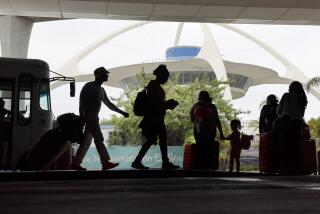Objections to Plans for Nixon Library in San Clemente Stall Development
Four years after supporters of former President Richard M. Nixon decided to build his official presidential library in San Clemente, the ocean-view site is still covered with weeds and no one can say when construction will begin.
Development of the Nixon archives has stalled as city officials have objected to plans by the Lusk Co. of Newport Beach for a 253-acre complex that also would include three hotels, 1,500 homes and a commercial center.
Impatient to build the library, officials of the Richard Nixon Presidential Archives Foundation last week threatened to pick another site.
Foundation directors have raised $24 million of the $25 million needed for construction, and they are eager to break ground on the 16.7-acre parcel that Lusk has set aside for the library, according to John C. Whitaker, the foundation’s executive director in Washington.
If the city and Lusk do not agree soon, “we will move,” he warned.
And according to San Clemente banker Anthony R. DiGiovanni, chairman of the local Nixon library committee, at least two groups “outside the San Clemente area” have submitted formal site proposals to the foundation and are now “eagerly vying” for the library.
“We are very interested in the library. It would be an asset to the community. And for Mr. Nixon’s sake, we would like to get on with it,” Councilman Brian Rice said. “However, we do not feel we would like to sell out any portion of the town for the library.”
Loss of the Nixon library could be a serious blow to the city, whoseleaders believe that the librarywould bring prestige--and additional tourists--to their quiet,ocean front town of 34,000. San Clemente Chamber of Commerce officials say an 80,000-square-foot library, containing a Nixon museu and millions of presidential documents and tapes, could bring the city $1 million to $2 million a year in added tourist revenues.
In 1969, President Nixon literally put San Clemente on the map when he bought an estate called La Casa Pacifica and made it the site of his Western White House. Before then, according to City Manager James Hendrickson, “there were maps of California that used to show San Juan Capistrano and Oceanside and nothing in between.”
Even after Nixon’s resignation in 1974, San Clemente residents have remained fond of the Nixons, Hendrickson said. And in April, 1983, the city’s Lusk cliff-side site won the competition as the site for the library.
Last week, according to Councilman William Mecham, Lusk officials decided to submit its Marblehead Coastal Specific Plan for the library, homes and hotels for formal public review--even though Lusk and the city still have not reach agreement despite 18 months of negotiations.
According to Hendrickson, Lusk’s proposal violates San Clemente’s planning guidelines in several ways.
Instead of preserving the bluffs and interior canyons, it would chop the property’s 100-foot oceanfront cliffs down to 60 feet, fill in three canyons and grade soils over the entire site.
In addition, according to San Clemente officials, a project of this size requires at least 76 acres of public park space--but the Lusk plan offers only about half that.
The project is getting especially close scrutiny, city officials said, because the Marblehead coastal property, formerly known as the Reeves Ranch, is one of the largest remaining parcels of undeveloped oceanfront land in Southern California.
“It’s a real gem,” said James Holloway, San Clemente’s community development director. The city’s job, he said, is to protect that land and its three canyons, including a small one near the ocean that is studded with pine trees.
Four-Lane Highway
But Don Stefenson, Lusk executive vice president, said his firm cannot afford more parkland. As it is, he said, the firm plans to spend more than $5 million to build a four-lane highway to the library, install utilities and grade the site.
Even if approved by the City of San Clemente, the project still must get past the California Coastal Commission. And at the moment, commission approval is not likely, commission and city planning officials said.
“I think we’d have major problems with it,” said Chris Kroll, a commission analyst. Commission policy is to preserve canyons and coastal bluffs, not cut and fill them, he said.
Another unresolved issue is that Nixon’s lawyers have not reached agreement with the National Archives for the release of the former President’s papers and tapes, archive spokeswoman Jill Brett said.
Private Financing
It was private citizens who financed each of the existing eight presidential libraries and then turned their operation over to federal archivists, Brett noted.
But foundation officials, concerned that the National Archives is releasing too many “sensitive” papers, are considering running a private library and controlling access to papers. And Brett said the archives has no plans to release the Nixon papers to a private institution that might be run as “a personal monument” rather than as a serious research institution.
Whitaker nevertheless said he is optimistic that the Nixon papers eventually will be released.
City officials are less sanguine. “I gave up my crystal ball a long time ago,” Mecham said.
Still, Hendrickson said he doesn’t believe that the Nixon library will end up someplace else. “It’s just a feeling or a hope or a prayer. . . . But the City Council, to a man, would like the library.”
More to Read
Sign up for Essential California
The most important California stories and recommendations in your inbox every morning.
You may occasionally receive promotional content from the Los Angeles Times.










